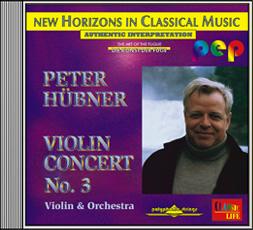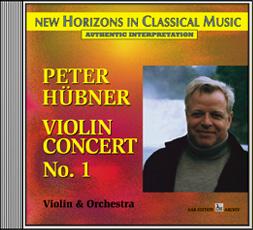PETER HÜBNER
Classical Composer • Musicologist
SPEAKS ON HIS VIOLIN CONCERTS
 CLASSIC-Life: Mr. Hübner, you have created 7 violin concertos which – I believe I can hear – are somehow related to each other.
CLASSIC-Life: Mr. Hübner, you have created 7 violin concertos which – I believe I can hear – are somehow related to each other.
PETER HÜBNER: Yes, these 7 violin concertos all refer to each other. This was important, as they develop contrapuntally.
The 4th violin concerto, for instance, is an integration of the 1st and 2nd violin concerto, the 5th violin concerto is an integration from the 1st and 3rd, the 6th violin concerto is an integration from the 2nd and 3rd, and the 7th violin concerto is an integration from the 1st, 2nd and 3rd violin concerto.
From the 2nd violin concerto onwards there is also a respective fugue in up to seven parts, which is played by the orchestra.
CLASSIC-Life: Which violin concerto do you yourself like best?
PETER HÜBNER: From my point of view, each of these violin concertos has of course its very own value. From a musical theoretical aspect, the first 3 violin concertos are surely the simplest – starting with the first. But for the start, I find the 3rd violin concerto the most attractive. But here, even my friends differ in their opinions.
From the 4th violin concerto on, recording wasn’t easy, due to the contrapuntal use of the different violin concertos, as the orchestra wasn’t to be pushed too far into the background – after all, besides many further motifs and themes, it was continuously playing a fugue in seven parts – and the solo violins and/or the solo viola had to be clearly audible, were to stand out from each other tonally, and merge again, and were, above all, to harmonise with each other in the continuity of the complex of themes.
As is well known, the means for a stereo version on CD are limited – even if we already use Dynamic Space Stereophony.
CLASSIC-Life: So, to start off with, you would recommend the 3rd violin concerto?
PETER HÜBNER: Personally, yes, I would, but I know others who recommend a different order. A friend, for example, regularly listens to the 7th. For me this is extraordinary, because he isn’t a music expert. From my point of view, I would have thought that the contrapuntal use in the concerto would only be most interesting for a music expert.
But the musical complexity and the counterpoint obviously have a strong effect on the subconscious.
CLASSIC-Life: Could you say something about your solo violin – that “Magic Violin”, as the label calls it?
PETER HÜBNER: Yes, I can tell you a few things. I had and have a number of violin sounds in digital form at my disposal – natural, artificial and mixed. I wasn’t looking for a violin which is a copy of the usual violin, but rather the convincing performance of music through a sound which is fundamentally related to that of the violin. That applies for one in a certain extent to the range and also to the process of swinging in as well as the overwave spectrum.
However, I neither wanted any scratching nor the feeling that you could hear some sort of wood. I also wanted a strong sound which, not only as far as volume goes, but also its overwave spectrum, could assert itself with an individual musical statement within the polyphony of the orchestra sound.
 And I think, all in all I was lucky. In the beginning you might miss that sound quality in this violin which you believe to hear in a conventional wooden violin, but once you have got used to the sound, listening at a later stage to a conventional piece of music on a wooden violin, it sounds subjectively more like a fiddle, and in comparison seems weak and less convincing.
And I think, all in all I was lucky. In the beginning you might miss that sound quality in this violin which you believe to hear in a conventional wooden violin, but once you have got used to the sound, listening at a later stage to a conventional piece of music on a wooden violin, it sounds subjectively more like a fiddle, and in comparison seems weak and less convincing.
When choosing an instrument and/or its sound, I am mainly concerned with the individual living multi-layered powers of persuasion.
I think it is worthwhile to listen and to get to know all seven violin concertos step by step, as they conceal a compositional-musical development which is only gradually revealed.









© COPYRIGHT 2010 PDB INTERNATIONAL, INC. • ALL RIGHTS RESERVED
with kind permission of AAR EDITION INTERNATIONAL